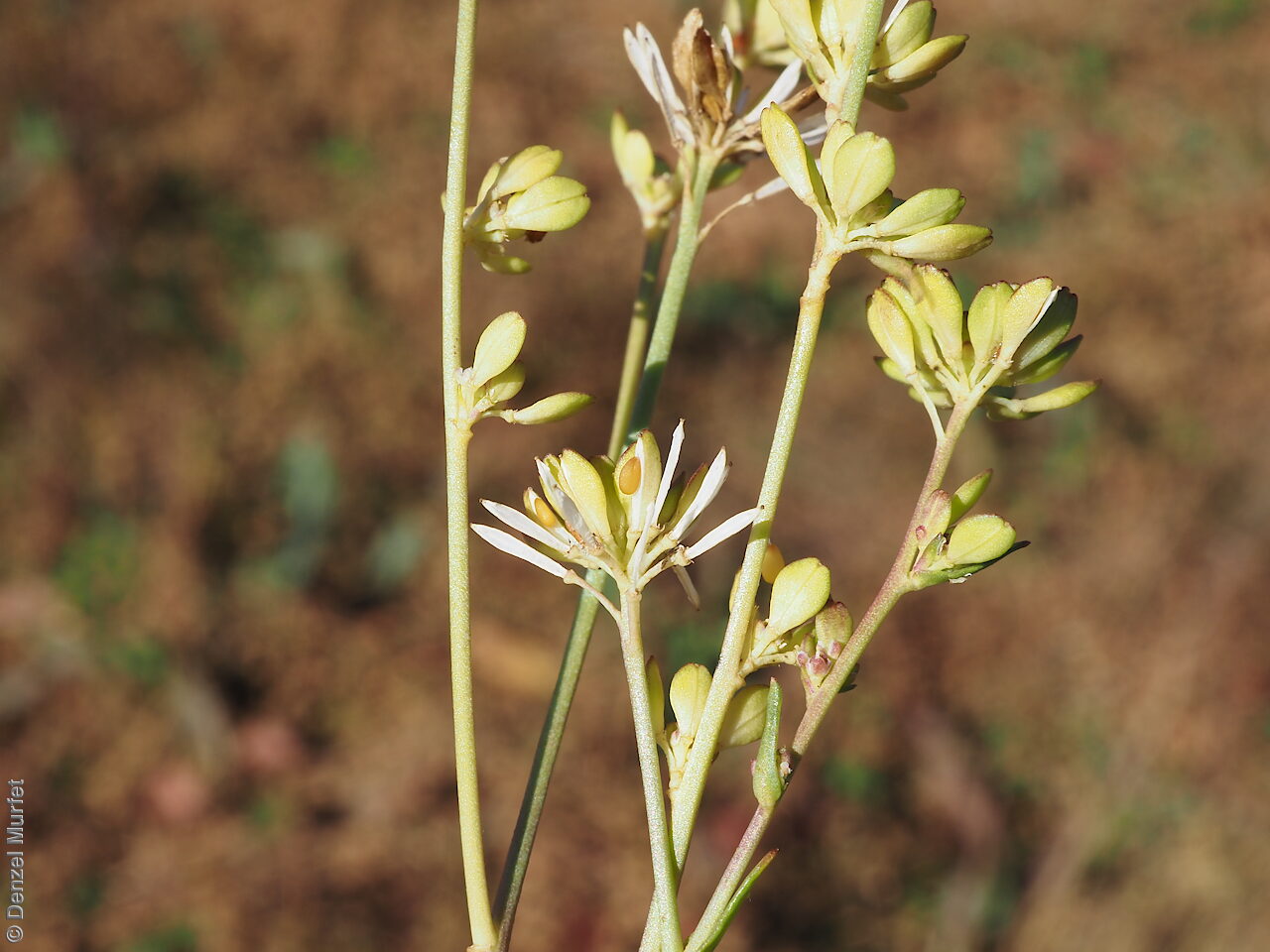Fascicled Peppercress,
Bundled Peppercress
Display all 10 images










Regional Species Conservation Assessments per IBRA subregion.


Least concern
Near threatened
Rare
Vulnerable
Endangered
Critically endangered
Extinct
Data deficient
Adelaide
Arkaroola
Ceduna
Coober Pedy
Hawker
Innamincka
Marla
Marree
Mount Gambier
Oodnadatta
Renmark
Wudinna
Keith
Yunta
Display IBRA region text
| Broughton (FLB02) | Flinders Lofty Block | Endangered (IUCN: EN B2ab(i,ii,iii)) (Definite Decline) |
| Olary Spur (FLB03) | | Rare (IUCN: RA d(i)) |
| Northern Flinders (FLB05) | | Vulnerable (IUCN: VU B2ab(i,ii,iii); D2) (Probable Decline) [no recent records] |
| Central Flinders (FLB06) | | Vulnerable (IUCN: VU B2ab(i,ii,iii); D2) (Probable Decline) [no recent records] |
| South Olary Plain (MDD01) | Murray Darling Depression | Vulnerable (IUCN: VU B2ab(i,ii,iii)) (Probable Decline) [grazed] |
| Murray Lakes and Coorong (MDD03) | | Data Deficient [checked by H Vonow] |
| Braemer (MDD07) | | Rare (IUCN: RA d(i)) |
| Murray Scroll Belt (RIV06) | Riverina | Vulnerable (IUCN: VU B2ab(i,ii,iii)) (Probable Decline) [grazed] |
| Myall Plains (GAW01) | Gawler | Vulnerable (IUCN: VU D2) (Probable Decline) |
| Gawler Volcanics (GAW02) | | Vulnerable (IUCN: VU B2ab(i,ii,iii)) (Probable Decline) [nthn record wrongly mapped] |
| Gawler Lakes (GAW03) | | Vulnerable (IUCN: VU B2ab(i,ii,iii)) (Probable Decline) [no records] |
| Arcoona Plateau (GAW04) | | Vulnerable (IUCN: VU B2ab(i,ii,iii)) (Probable Decline) |
| Kingoonya (GAW05) | | Vulnerable (IUCN: VU B2ab(i,ii,iii)) (Probable Decline) |
| Torrens (GAW06) | | Vulnerable (IUCN: VU B2ab(i,ii,iii); D2) (Probable Decline) |
| Nullarbor Plain (NUL02) | Nullarbor | Vulnerable (IUCN: VU B2ab(i,ii,iii)) (Probable Decline) |
| Barrier Range (BHC01) | Broken Hill Complex | Rare (IUCN: RA d(i)) |
| Barrier Range Outwash (BHC04) | | Rare (IUCN: RA d(i)) |
| Bimbowrie (BHC05) | | Rare (IUCN: RA d(i)) |
| Curnamona (BHC06) | | Rare (IUCN: RA d(i)) |
| Strzelecki Desert (SSD05) | Simpson Strzelecki Dunefields | Data Deficient [query ID] |
| Murnpeowie (STP03) | Stony Plains | Vulnerable (IUCN: VU B2ab(i,ii,iii); D2) (Probable Decline) |
| 4 of 6 subregions | Flinders Lofty Block | Rare , Vulnerable , Endangered |
| 3 of 6 subregions | Murray Darling Depression | Rare , Vulnerable , Data Deficient |
| Murray Scroll Belt (RIV06) | Riverina | Vulnerable (IUCN: VU B2ab(i,ii,iii)) (Probable Decline) [grazed] |
| 6 of 8 subregions | Gawler | Vulnerable |
| Nullarbor Plain (NUL02) | Nullarbor | Vulnerable (IUCN: VU B2ab(i,ii,iii)) (Probable Decline) |
| 4 of 4 subregions | Broken Hill Complex | Rare |
| Strzelecki Desert (SSD05) | Simpson Strzelecki Dunefields | Data Deficient [query ID] |
| Murnpeowie (STP03) | Stony Plains | Vulnerable (IUCN: VU B2ab(i,ii,iii); D2) (Probable Decline) |
Prior names
Lepidium ruderale var. simplicissimum
Lepidium sagittulatum var. fasciculatum
Lepidium ruderale
Common names
Fascicled Peppercress
Bundled Peppercress
Etymology
Lepidium from the Greek 'lepis' meaning a scale; referring to the appearance of the fruits. Fasciculatum from the Latin 'fasciculus' meaning fascicle; referring to the clustered inflorescence.
Distribution and status
Found scattered across the central part of South Australia, growing in heavy clay depressions. Also found in Western Australia, Queensland, New South Wales and Victoria. Native. Common in South Australia. Rare in Western Australia. Uncommon in Victoria. Common in the other states.
Herbarium regions: Lake Eyre, Nullarbor, Gairdner-Torrens, Flinders Ranges, Eastern, Eyre Peninsula, Northern Lofty, Murray, Yorke Peninsula
AVH map: SA distribution map (external link)
Plant description
Erect annual herb to 60cm tall, glabrous, sometimes pubescent when young. Leaves basal and alternating up the stems. Basal leaves to 8 cm long, hairy, divided, the segments linear and shaped like teeth, rarely persisting. Stem leaves to 6 cm long, with basal lobes, reducing to linear, hairless, with warty edges. Flowers small, green in dense clusters at the tops of the stems. Flowering between May and December. Fruits are orange-brown ovoid capsule to 4 mm long and 2 mm wide, glabrous, wing slight in the upper half, with a shallow notch. Seed embryo type is bent.
Seed collection and propagation
Collect seeds between August and February. Collect maturing pods those turning orange with hard seeds inside. Be gentle with the pods as they split open easily. Place the pods in a tray and cover with paper to prevent seeds from popping out and leave to dry for a week. Then rub the dried pods gently by hand to dislodge the seeds. Use a sieve to separate the unwanted material. Store the seeds with a desiccant such as dried silica beads or dry rice, in an air tight container in a cool and dry place.
| Location | No. of seeds
(weight grams) | Number
of plants | Date
collected | Collection number
Collection location | Date
stored | % Viability | Storage
temperature | BGA
MSB | 10,500 (2.89 g)
10,500 (2.89 g) | 200+ | 22-Oct-2008 | MJT157
Eastern | 20-Jul-2009 | 100% | -18°C |
Location: BGA — the seeds are stored at the Adelaide Botanic Gardens, MSB — the seeds are stored at the Millennium Seed Bank, Kew, England.
Number of plants: This is the number of plants from which the seeds were collected.
Collection location: The Herbarium of South Australia's region name.
% Viability: Percentage of filled healthy seeds determined by a cut test or x-ray.









